This summer, we’re writing a series of blog posts about the Bakehouse’s recent trip to Turkey to explore Sephardic Jewish cuisine. Leading us on this culinary journey are Bakehouse Managing Partner, Amy Emberling, and Hazim Tugun, the Bakehouse’s Bread Baker extraordinaire, who also lends his hands at the Bakehouse as a miller, bread recipe developer, teacher, and writer. Thus far, we’ve covered Amy’s return to Istanbul after a 36-year hiatus and the group’s first day, a culinary tour of the Istanbul neighborhood of Kurtuluş, where they spent a most flavorful six hours. Today, we want to share our three days of learning on Burgazada Island with Lian Penso (our guide to the Jewish community of Istanbul) and her Aunt Simone.
As we planned our visit with Lian, through many emails and zoom meetings, she let us know that we might want to spend much of our time on the island where many members of the Jewish community go during the hot summer months. Neither Hazim nor I knew anything about Burgazada Island, but it certainly sounded like a beautiful setting for learning. Lian believed, since people would be more relaxed there and more easily available, we could drop in on folks for quick conversations and that they also could drop by her apartment to share their memories with us. She was right!

The Trek to Burgazada
We started our trek to Burgazada with a 10-minute downhill walk from our hotel in Istanbul to the port of Kabataş where we caught a ferry to the Princes’ Islands. Burgazada Island is one of the four main islands of this group, all in the Sea of Marmara near Istanbul. The Princes’ Islands used to be islands of exile for out-of-favor members of royalty and the Sultan’s family, but in the 19th century, they became a place of rest and relaxation for the wealthy members of the Istanbul community. This included Turkish Muslims, Greek and Armenian Christians, and Jews, reflecting the diversity and inclusivity of the Ottoman Empire.
Today, each island is still associated with a particular group; although Turkish Muslims are by far the majority on each island. Burgazada, named in reference to a fort built by one of the Diadochi (Successors) of Alexander the Great, is considered the island of the Jews and had primarily Jewish residents until the middle of the 20th century.
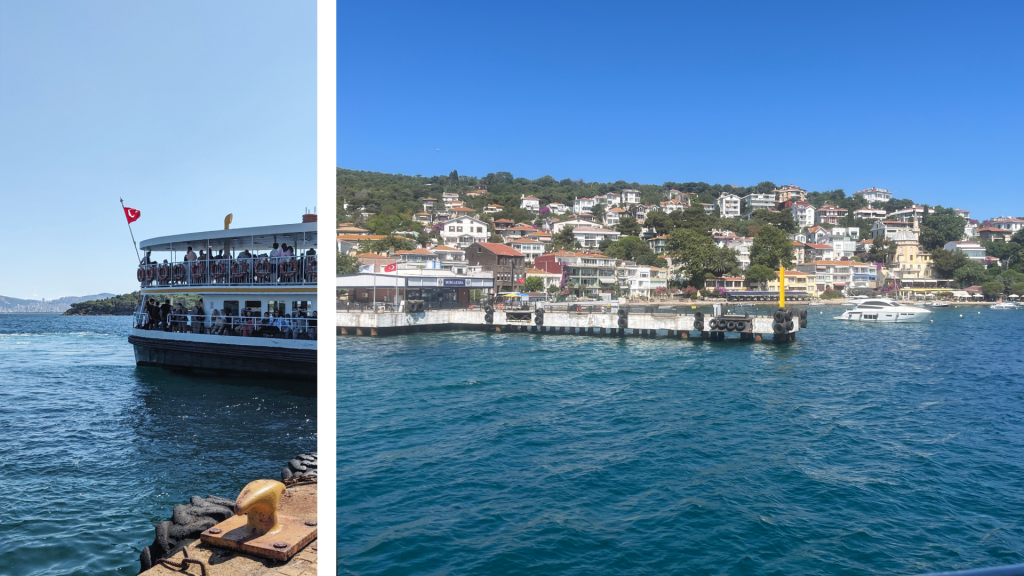
Our ferry was filled with happy locals, young families, twenty somethings, and retirees all ready for a Sunday of R&R on one of the islands. The feeling was festive. Consistent with the diversity we were seeing in Istanbul, there were people dressed in fashionable western outfits and women covered in more traditional muslim clothes. Everyone, no matter their background or beliefs, was ready to enjoy the islands. The ride was smooth with beautiful views and a wonderful cooling breeze. I could have stayed on the boat for hours. Hazim told us that a friend of his sometimes just rides on the ferries for a break from the intensity of city life. I can understand why.
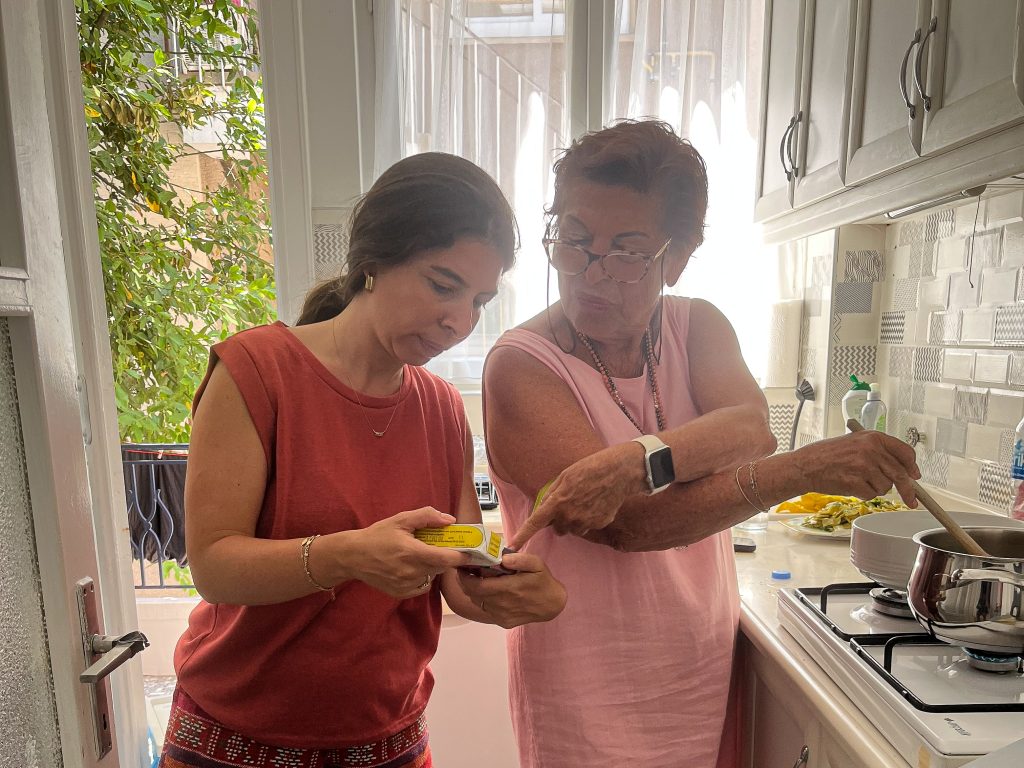
As we disembarked on Burgazada, we immediately sensed the island’s relaxed vibe. We looked back and could still see the skyline of Istanbul, realizing we were both far and not far at all. We searched in the crowd for our guide, Lian. Would we recognize her? So wonderful to be in the same place after our months of planning.
Meeting Lian, Aunt Simone, and the Cookie Man
There she was! She was with a stylish woman in a pretty loose pink linen dress (perfect for the heat). This is something I will remember if we are able to return again in the summer. Lian introduced us to her Aunt Simone. She would be our primary teacher about food and history for the next few days. They both emanated warmth and excitement about our joint project. We quickly sorted out which language we would communicate in. Simone offered Turkish, English or French! Turkish and English won out and French would be our backup.
Lian and Simone wanted to orient us to the island. We took a short walk around the commercial part of the island and shared some tea and pastries together to get acquainted. It was clear that this was a small community in which many people knew each other. There were frequent hellos, hugs and kisses, and a few looks of people wondering who these strangers that Lian and Simone were showing around might be. Simone, now 75, had been coming here since she was a child. Her ease and comfort in the surroundings was obvious. For both of them, this was clearly their place.

We met the Cookie Man of the island with his cart of cookies. An island staple who works all day walking the island selling treats made in Istanbul, the Cookie Man has been a part of the community for at least 40 years and is an important symbol of continuity. Think the ice cream truck for a similar American tradition, but imagine if it had been the same driver every summer. Next, we visited a church that Lian particularly loved for its beauty. Then it was off to Lian’s apartment.
Lessons in Jewish Sephardic Cooking
Before diving into the details of our afternoon, let me share some of the general characteristics of Jewish Sephardic cooking that we were learning about. In terms of technique, many of the dishes have multiple steps, which could include boiling, frying, and then cooking again. In general, from a home cook’s perspective, the dishes are often detailed and take significant time to prepare and the primary techniques used are frying and baking. Most vegetable dishes have more than one vegetable in them as well.
It is a cuisine that takes pride in not wasting. Everything is used! Considering that many Sephardic Jews over the ages have struggled economically, this is not a surprising characteristic. This resonated with me and is aligned with the common Ashkenazi saying, “Waste not, want not.” Additionally, it is a cuisine in which the vegetable dishes outnumber the meat dishes. Why? Well, it could be that this made it easier to follow kosher rules. It could also reflect the economic challenges of the community, vegetables being less expensive than meat.
The names of dishes can be confusing. Not knowing Turkish or Ladino (the language of Sephardic Jews, which is based on medieval Spanish), I kept asking what language the names we were being told were in. On top of this, we learned that the dishes can have different names depending on the region the cook is from.
As for the common ingredients, lemon, parsley, and tomatoes are used in many dishes to enhance their flavor. One point of confusion that we still haven’t completely sorted out is the use of garlic and onions. From what we’ve read, they are used; from what we were told by our Turkish teachers, they are not used. Lian and Simone shared this opinion with us and it was later confirmed by our hosts in Izmir. Chicken, lamb, beef, offal, and many fish are common proteins. There is a rich repertoire of eggs as well. Eggplant, potatoes, spinach, artichokes, and leeks are commonly used vegetables. Sunflower oil is the current fat of choice. Cheese is a common element. Many savory and sweet dishes are made with a dough called yufka. It looks like phyllo dough but is not exactly the same. It is a relation to both phyllo dough and strudel dough.
Desserts are an important part of the cuisine. Nuts of many kinds are in the recipes. We mainly saw the use of almonds and walnuts. I was surprised to discover how prominent marzipan was and that it’s still made at home. This is something very rare, in the United States at least. Desserts for Jewish holidays are common and we discovered some interesting variations from the Ashkenazi tradition. For instance, hamentashen, called orejas de aman in Ladino (ears of hamen) are made with semolina flour and deep fried! In the Ashkenazi tradition, they are baked and made from either a yeasted dough or a simpler cookie dough.
We asked what was common for a Friday night Sabbath meal and were surprised to hear that soup was not an important element and that both fish and chicken or beef were served. Simone recounted that after eating the fish, she and her brother would always ask their mother, ”But where is the meat?” There are particular menus for Shabbat dinner, Saturday breakfast, and each holiday. Our time with Lian and Simone was short however, and we’ll need to return to explore these meals more deeply.
We spent the afternoon cooking, talking, and eating.
Lunch is Served
One of our favorites was a chilled salad of zucchini skins seasoned with lemon, dill, and a pinch of sugar. Simone explained that it is sometimes eaten with small green sour plums or tomatoes. The Ladino name for this dish is kashkarikas. Although simple, it was a satisfying salad on a very hot day. It was evident how perfectly it fit with the environment and the desire to minimize waste. One challenge of making a cuisine in a different context, is having it make sense once the environment changes. I could see how this salad could be well received in the heat of July or August in Ann Arbor.
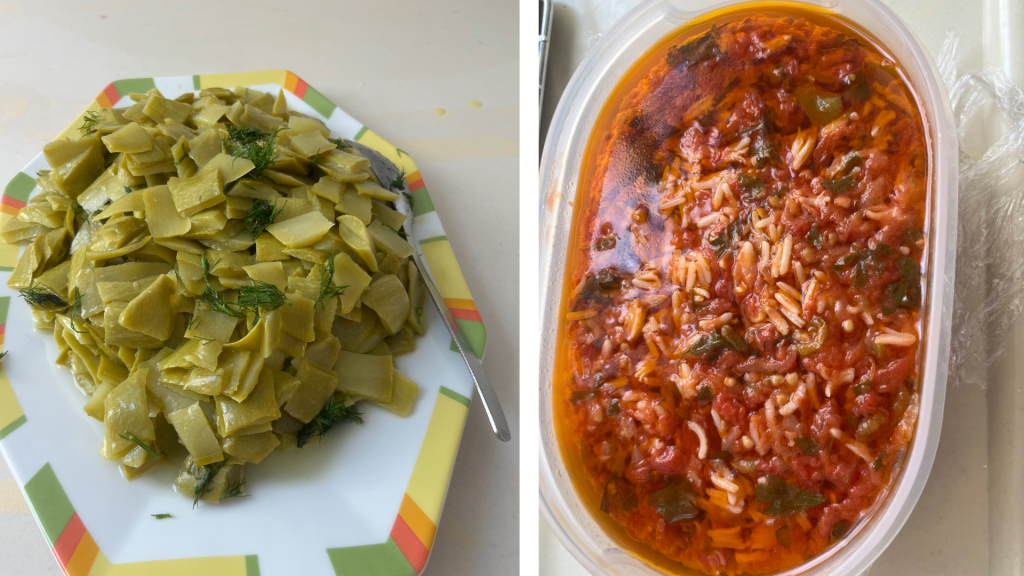
Simone had made armiko de domate ahead of our visit for us to taste. This is a tomato stew that is then served chilled or at room temperature. It is flavored with onions, green peppers, rice, parsley, and a touch of sugar. Simone shared that this dish is sometimes made with green tomatoes. With the wonderfully tasty local tomatoes, this dish was a treat. One difficult aspect of translating this cuisine to Ann Arbor is the amazing abundance in Turkey of very fresh, flavorful produce. It’s possible for the dishes to be simple because so much flavor comes from the vegetables themselves. We aren’t always as fortunate in Ann Arbor.

We made cheese-filled bulemos with Simone. They had bought the ever important yufka dough, filling and rolling it with a mixture of cheeses set in a pan, with beaten eggs poured over them and then baked. They were a delicious combination of salty cheese, crisp dough, and flavorful eggs.
For dessert we enjoyed semola, a pudding-like dessert made from semolina. There are many versions of this dessert—flavored with cinnamon or lemon and cooked with milk or water or both. All versions contain sugar. Today we had the light summer version with water and lemon. It was refreshing and light. Hazim shared with us that his mother made her own version of this. She opted to toast the semolina in the pan prior to adding any liquid. We’re looking forward to playing with this recipe and sharing it with our customers when back at the Bakehouse.
Beside what we actually made, Simone shared memories of foods that suddenly came to mind, after years of never thinking about them. One memory we coined, “Sephardic deviled eggs”, was of boiled eggs, cut in half, and the yolks mixed with butter and sardines—something I need to try. Another version of this was something her father often ate – sardines mixed with bottarga (salted fish roe) and butter on bread. His name was Hazday Penso and he was actually on the Turkish national basketball team at the 1936 Olympics in Berlin; an interesting bit of Sepahrdic Jewish trivia.
After our initial cooking session, it was time for a break and visits with friends. More on that in our next post.
She has been an avid food lover and baker since her childhood in Nova Scotia, Canada. After high school Amy moved to Cambridge, MA and received her bachelor’s degree from Harvard University. She then followed her passion for food and learned to cook and bake at L’ecole de Gastronomie Francaise at the Ritz Hotel in Paris, France as well as in Michigan restaurants. In 1999 she received her MBA from Columbia University.
Amy came to Zingerman’s Bakehouse when it opened in 1992 as one of the original bakers on the staff of eight. She soon became the first manager of the bread bakery, then the manager of the pastry kitchen and in 2000 she became a partner.
Amy has been working in the food world for over 20 years and is passionate about hands-on baking, teaching about baking and business, developing businesses and people. As well as teaching at BAKE! Amy presents for ZingTrain on our business practices. A few of the Bakehouse items she is personally responsible for developing are the Old School Apple Pie, Buenos Aires Brownies, and our Gingerbread Coffeecake. In addition to developing items, Amy is a promoter of classic bakery favorites from many cultures and has brought traditional standards to the Bakehouse such as Paris Brest, Hummingbird Cake, and Maple Cream Cookies.


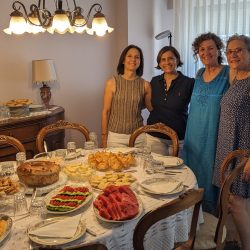
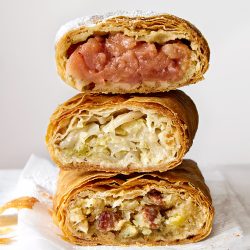
Seems like an interesting introduction to Sephardic cooking, especially the hamantaschen. Thanks. Looking forward to reading more.